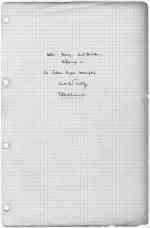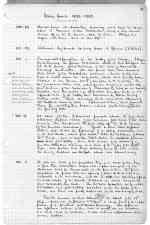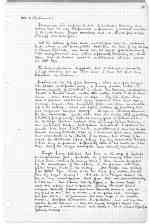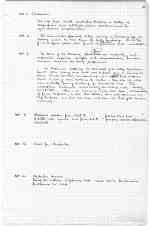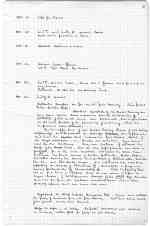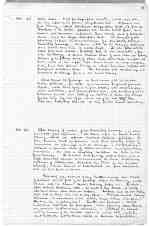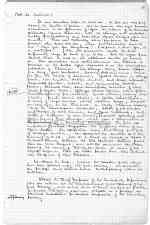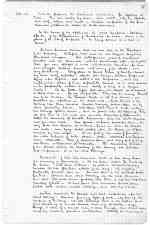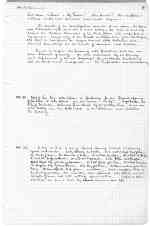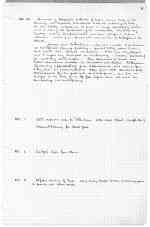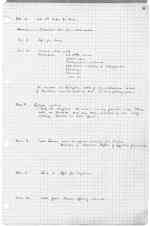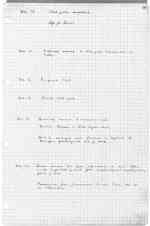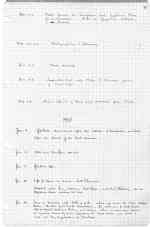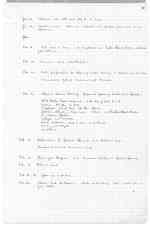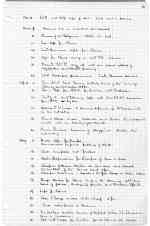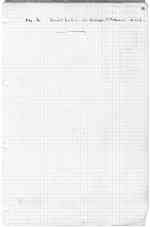Excavation journals and diaries made by Howard Carter and Arthur Mace
Howard Carter's excavation diaries (transcripts and scans)
1st Season, October 28th 1922 to May 30th 1923
This is Howard Carter's journal for the 1st excavation season of the tomb of Tutankhamun which took place during the Winter of 1922-3. The events covered by this journal are the discovery of the tomb stairway (November 4th 1922), the uncovering of the first sealed doorway (November 5th 1922), Carter's captivating account of peering into the Antechamber of Tutankhamun's tomb for the first time (November 26th 1922), and the death of Carter's patron Lord Carnarvon (April 5th 1923).
The journal is housed within its original black ring-binder, stamped "Walker's Loose-Leaf Book, Cover Number 138" on the inside front cover, it measures 33 by 21.5 by 1 cm. and contains 148 loose-leaf, graph-lined pages. TAA Archive i.2.1, pages 25 to 53. All entries are in Howard Carter's hand except for those between December 5th and 27th 1922 (pages 43 to 47) which were entered by Arthur C. Mace.
This transcript follows the format of the original document, and any insertions, deletions or duplications are indicated accordingly. Scans of the original journal pages are provided and are positioned to the right of the transcript, these are magnified by positioning the pointer on the image.
Referring to,
the Theban Royal Necropolis
and the Tomb of
Tutankhamen
Arrived Luxor on Saturday
train to Erement to see Callender, living in his small
house on the E. bank, near the river. Stayed the
night with him and on the 29th.
Returned by small sailing boat to Gurna (3 1/2 hrs).
Commenced operations in the Valley of the Kings. I began
by continuing the former excavation where it had stopped at
the N.E. corner of the entrance to the tomb of Ramses VI,
trenching southwards. At this point there were ancient
stone huts of the Necropolis workmen, built rather less
than a metre above the bed-rock, which had partly been
exposed in our former work x (see plan L.M. 15 and 16). As
we uncovered them they were found to continue under the
and in front of the entrance of Ramses VI tomb in a southerly
direction and connected up with other similar huts on the
opposite side of the valley bed discovered by Davis during
previous work. These ancient huts were soon cleared of
the rubbish covering them. I planned them, and removed
them for investigation below, which undertaking took until
the fourth of Nov.
These huts were
built upon the
natural detritus,
and were covered by
At about 10am I discovered beneath almost the first hut
attacked the first traces of the entrance of the tomb (Tût.ankh.
Amen) This comprised the first step of the N.E. corner
(of the sunken-staircase). Quite a short time sufficed
to show that it was the beginning of a steep excavation cut
in the bed rock, about four metres below the entrance of Ramses
VI's tomb, and a similar depth below the natural Present
leve level of the valley. And, that it was of the nature of a
sunken staircase entrance to a tomb of the type of the XVIIIth
Dyn., but further than that nothing could be told until
the heavy rubbish at the foot above was cleared away.
It took the whole of the preceding day and most of this day
to free this excavation before the upper margins of the
staircase could be demarcated on its four sides. As first
conjectured it proved to be an opening (about 4 ms x 1.60 ms)
excavated in the bed-rock, with its W. side end abutting against
the rock slope of the small hillock in which Ramses VI
had excavated his tomb. As the work proceeded we found that
the western end of the cutting receded under the slope of the
rock, and thus was partly roofed over by the overhanging rock.
Towards sunset we had cleared down to the level of the 12th
step, which was sufficient to expose a large part of the upper
portion of a plastered and sealed doorway. Here before us
was sufficient evidence to show that it really was an entrance
to a tomb, and by the seals, to all outward appearances that
it was intact.
I examined this exposed portion of the sealed doorway and
noticed that the only decipherable impressions of the seals were those
of the well-known Royal Necropolis seal, i.e., Anubis (symbolizing
a king) over nine foes.
With the evidence of these seals, and the fact that the workmen's
huts, which in all probabilities dated from the time of the construction
of Rameses VI's tomb, were built over the mouth of the entrance of
this newly discovered tomb without apparently disturbing it, it was
clear that its content would be undisturbed at least since
the XXth Dyn.
The seal-impressions suggested that it belonged to somebody of
high standing but at that time I had not found any
indications as to whom.
I noticed at the top of the doorway, where some of the cement-
like plaster had fallen away, a heavy wooden lintel. To
assure myself of the method in which the doorway was blocked,
I made a small hole under this wooden lintel - the R. hand
corner, about 35 x 15 cms in size. By this hole I was
able to perceive with the aid of an electrical torch that the a
passage beyond was completely filled with stones and rubble
up to its ceiling, which was again evidence of something that
had required careful closing. It was a thrilling moment
for an excavator, quite alone save his native staff of workmen,
to suddenly find himself, after so many years of toilsome work,
on the verge of what looked like a magnificent discovery -
an untouched tomb. With certain reluctance I reclosed the
small hole that I had made, and returned to another careful
search among the seals to see if I could not find some indication
that would point to the identity of the owner, but it was of no
avail for the small space bared by my excavation did not
expose any impression sufficiently clear to be made out, other
than that of the Royal Necropolis seal already mentioned.
Though I was satisfied that I was on the verge of perhaps
a magnificent find, probably one of the missing tombs that
I had been seeking for many years, I was much puzzled
by the smallness of the opening in comparison with those
of other royal tombs in the valley. Its design was certainly
of the XVIIIth Dyn. Could it be the tomb of a noble, buried
there by royal consent? Or was it a royal cache? As
far as my investigations had gone there was absolutely nothing
to tell me. Had I known that by digging a few inches deeper I
would have exposed seal impressions showing Tût.ankh.Amen's
insignia distinctly I should would have fervently worked on and set
my mind at rest, but as it was, it was getting late, the night
had fast set in, the full moon had risen high in the eastern
heavens, I refilled the excavation for protection, and with my men
selected for the occasion - they like myself delighted beyond all
expectation - I returned home and cabled to Ld. C. (then in England) the
following message:-
"At last have made wonderful discovery in Valley a
magnificent tomb with seals intact recovered same for
your arrival congratulations"
The men worked feverishly today covering and making safe the
discovery until the time came for fully re-opening. On the top
of which great stones, that formed the sides of the ancient huts, were rolled.
The news of the discovery spread fast all over the country, and
and inquisitive enquiries mingled with congratulations from this
moment became the daily programme.
We continued clearing the bed-rock of the valley towards the
south where many more huts were exposed and on turning the
corner towards the west we opened up, at a
huts a sort of stone enclosure for mortar - these like the others
were evidently part of the camp for Ramses VI tomb. This
investigation continued until the end of the working week - Monday,
the 13th Nov. Here, as I found in most other cases, the excavations
of former explorers, in this case Davis, had only skimmed the
top surface and had not even laid bare the huts of the ancient
workmen.
Received wireless from Lord C. "… possibly come soon …"
A little later another wire from Ld. C. "propose arrive Alexandria
twentieth …"
Wired for Callender.
Callender arrived.
During the interim to following date made various preparations
for opening the tomb.
Left for Cairo.
Lord C. and Lady E. arrived Cairo.
Made various purchases in Cairo.
Arrived Returned to Luxor
Arrived Luxor-Gurna
Ld C. left Cairo for Luxor.
Lord C. arrived Luxor, came over to Gurna and put up
at my house.
Callender re-started uncovering tomb.
Lady E. arrived.
Callender reached as far as the first doorway. There proved
to be sixteen steps.
Now that the whole of the sealed doorway was
laid bare various seal impressions bearing the cartouche of
 of Tût-ankh-Amen were discernible, more in particular
of Tût-ankh-Amen were discernible, more in particular
in the lower portion of the plastering of the doorway where the
impressions were clearest.
In the upper part of this sealed doorway traces of two distinct
re-openings and successive re-closings disclosed were apparent,
and that the sealed seal-impressions first noticed, Nov. 5, of
the Royal Necropolis - i.e., 'Anubis over Nine Foes', had been
used for the re-closing . Here was evidence of at least the
reign of the discov tomb, but its true significance was still a
puzzle, for in the lower rubbish that filled the stair-case
entrance we found masses of broken potsherds, broken boxes,
the latter bearing the names and protocol of Akhenaten, Smenkh-
Ka-Ra, and Tut-ankh-Amen, and with what was even more
upsetting a scarab of Tehutimes III, as well as a fragment
bearing the cartouche of Amenhetep III. These conflicting data
led us for a time to believe that we were about to open a
royal cache of the El Amarna branch of the XVIIIth Dyn. Monarchs,
and that {the} from the evidence mentioned above it had been
probably opened and used more than once.
Engelbach, the Chief Inspector Antiquities Dept., came and witnessed
the freeing of rubbish from the first doorway. With him came several
of his friends, among others Brunton.
Slept the night in the valley. Carpenters commenced upon making
a temporary wooden grill for fixing over first doorway.
Noted seals. Made photographic records, which were not,
as they afterwards proved, very successful. Opened the
first doorway; which comprised rough stones built up from the
threshold to the lintel, plastered over on the outside face, and
covered with numerous impressions from various seals of Tut-ankh-
Amen and the Royal Necropolis seal. The removal of this
blocking exposed the commencement of a completely blocked
descending passage, the same width as the entrance staircase
and rather more than 2 metres high. It was filled with its
local stone and rubble, probably from its own excavation, but
like the doorway it showed distinct traces of more than one filling;
the mass of the filling being of clean white stone chips mingled with
dust, while in the upper left hand corner a large irregular
hole had been pierced through it which had been refilled with
dark flint and chert stones. This coincided with reopenings and
successive re-closings found on the sealed doorway.
As we cleared the passage we found mixed with the rubble
broken potsherds, jar seals, and numerous fragments of small
objects; water skins lying on the floor together with alabaster jars,
whole and broken, and coloured pottery vases; all pertaining to some
disturbed burial, but telling us nothing to whom they belonged
further than by their type which was of the late XVIIIth Dyn.
These were disturbing elements as they pointed towards plundering.
After clearing 9 metres of the descending passage, in about
the middle of the afternoon, we came upon a second sealed
doorway, which was almost the exact replica of the first. It
bore similar seal impressions and had similar traces of
successive re-openings and re-closings in the plastering.
The seal impressions were of Tût-ankh-Amen and of the Royal
Necropolis, but not in any way so clear as those on the
first doorway. The entrance and passage both in plan and in
style resembled almost to measurement the tomb containing
the cache of Akhenaten discovered by Davis in the very near
vicinity; which seemed to substantiate our first conjecture
that we had found a cache.
Feverishly we cleared away the remaining last scraps
of rubbish on the floor of the passage before the doorway, until
we had only the clean sealed doorway before us. In which,
after making preliminary notes, we made a tiny breach in the top
left hand corner to see what was beyond. Darkness and the iron testing
rod told us that there was empty space. Perhaps another descending
staircase, in accordance to the ordinary royal Theban tomb plan?
Or may be a chamber? Candles were procured - the all
important Tell-Tale for foul gases when opening when opening
an ancient subterranean excavation - I widened the breach
and by means of the candle looked in, while Ld. C., Lady E,
and Callender with the Reises waited in anxious expectation.
It was sometime before one could see, the hot air escaping
caused the candle to flicker, but as soon as one's eyes became
accustomed to the glimmer of light the interior of the chamber
gradually loomed before one, with its strange and wonderful
medley of extraordinary and beautiful objects heaped upon one
another. There was naturally short suspense for those
present who could not see, when Lord Carnarvon said to
me 'Can you see anything'. I replied to him Yes, it
is wonderful. I then with precaution made the hole
sufficiently large for both of us to see. With the light of an
electric torch as well as an additional candle we looked
in. Our sensations and astonishment are difficult to
describe as the better light revealed to us the marvellous
collection of treasures: two strange ebony-black effigies
of a King, gold sandalled, bearing staff and mace, loomed
out from the cloak of darkness; gilded couches in strange
forms, lion-headed, Hathor-headed, and beast infernal;
exquisitely painted, inlaid, and ornamental caskets;
flowers; alabaster vases, some beautifully executed of lotus
and papyrus device; strange black shrines with a gilded
monster snake appearing from within; quite ordinary looking white
chests; finely carved chairs; a golden inlaid throne;
a heap of large curious white oviform boxes; beneath
our very eyes, on the threshold, a lovely lotiform wishing
-cup in translucent alabaster; stools of all shapes
and design, of both common and rare materials; and,
lastly a confusion of overturned parts of chariots glinting with
gold, peering from amongst which was a mannikin.
the furniture The first im
impression of which suggested the property-room of an
opera-house of a vanished civilization. Our sensations were bewildering and full
of strange emotion. We questioned one another as to the
meaning of it all. Was it a tomb or merely a cache?
A sealed-doorway between the two sentinel statues proved
there was more beyond, and with the numerous cartouches
bearing the name of Tut-ankh-Amen on most of the
objects before us, there was little doubt that there behind
was the grave of that Pharaoh.
We closed the hole, locked the wooden-grill which
had been placed upon the first doorway, we mounted
our donkeys and return home contemplating what we
had seen.
Advised the Chief Inspector of the Antiquities Department,
who was with us at the commencement of the opening of the
first doorway, and asked him to come as soon as possible,
preferably the following afternoon to enable us to prepare an
electrical installation for careful inspection of this extraordinary
and pleasing discovery.
Callender prepared the electrical installation for lighting the
tomb. This was ready by noon, when Lord C., Lady E., Callender
and self entered and made a careful inspection of this first
chamber (afterwards called the Ante-chamber).
In the course of the afternoon the local Inspector, Ibrahîm
Effendi, of the Department of Antiquities at Luxor, came in the
place of the Chief Inspector - he being absent on a visit to
Kena.
It soon became obvious that we were but on the threshold
of the discovery. The sight that met us was beyond anything
one could conceive. This heterogeneous mass of material
crowded into the chamber without particular order, so crowded
that you were obliged to move with anxious caution, for time
had wrought certain havoc with many of the objects, was
very bewildering. Everywhere we found traces of disorder caused
by some early intruder, objects over-turned, broken fragments
lying upon the floor, all added to the confusion, and the
unfamiliar plan of tomb repeatedly caused us to ask ourselves
in our perplexity whether it was really a tomb or a Royal
Cache? As the better light fell upon the objects we endeavoured
to take them in. It was impossible. They were so many. Beneath
one of the couches, the Thoueris couch in the S.W. corner, we
perceived an aperture in the rock-wall which proved to be
nothing less than another sealed-doorway broken open as by
some predatory hand. With care Ld. C. and I crept under
this strange gilded couch, and we peered into the opening. There
we saw that it led into yet another chamber (afterwards
called the Annexe) of smaller dimensions than the Ante-chamber
and of a lower level. Even greater confusion prevailed here, the
very stones that blocked the entrance, forced in when the breach
was made, were lying helter-skelter upon the objects on the floor
crushed by their weight. It was full of one mass of furniture.
An utter confusion of beds, chairs, boxes, alabaster and faience
vases, statuettes, cases of peculiar form, and every sort of thing
overturned and searched for valuables. The remaining portions
of the plaster covering the blocking of this doorway bore similar
seal-impressions as on the other doorways.
In neither of these two chambers could we see any traces
of a mummy or mummies - the one pious reason for making
a cache. With such evidence, as well as the sealed doorway
between the two guardian statues of the King, the mystery
gradually dawned upon us. We were but in the anterior portion
of a tomb. Behind that closed doorway was the tomb-chamber,
and that Tût-ankh-Amen probably lay there in all his magnificent
panoply of death - we had found that monarch's burial place
intact save certain metal-robbing, and not his cache.
We then examined the plaster and seal-impressions upon the
closed doorway. They were of many types of seals, all bearing the
insignia of the King. We also discovered that in the bottom part
of the blocking a small breach had once been made, large
enough to allow of a small man to pass through, but it had been
carefully reclosed, plastered and sealed. Evidently the tomb beyond
evidence to tell that someone had made ingress.
The results of our investigations were, (1) it was clear the place
was Pharaoh's tomb and not a mere cache; (2) that we had only
entered the anterior chambers of the tomb, filled with magnificent
equipment equal only to the wealth and splendour of the New Empire;
(3) that we had found a royal burial little disturbed save
hurried plundering at the hands of ancient tomb robbers.
It was a sight surpassing all precedent, and one we
never dreamed of seeing. We were astonished by the beauty
and refinement of the art displayed by the objects surpassing
all we could have imagined - the impression was overwhelming.
Most of this day was spent in preparing for an official opening
of the tomb to take place on the morrow - the 29th. Engelbach, the
Chief Inspector, returned from Kena by the midday train, came over
to the Valley on his motor-cycle in the afternoon and inspected
the discovery.
Today we had a sort of official opening to which the following
guests were invited: Lady Allenby and AdC; H.E. Abdel Aziz Bey Yehia,
the Mudir of Kena; the Maamur of Luxor; Mr and Mrs Maudsley; Mr and Mrs K. Boyde;
Mr and Mrs de Garis Davies; Mr and Mrs Engelbach; Lady Downes and daughter;
Abdel Razik Bey of the Mus. Of Agriculture; Mr and Mrs Merton of the Times; Mr and Mrs Brunton;
The Irrigation Insp. Of Kena district; Wise Bey of the Police; the Commandant of the Kena
Police; Ibreheem Effendi, Insp. Of Luxor; and others. Lunch was given 12.30 at
the head of the valley - near tomb No. 15, when afterwards Lady Allenby and H.E.
the Mudir of Kena with Ld. C. and self opened the tomb. A special report
to The Times was sent to Luxor by special runner - about 3pm.
A number of Egyptian notables of Luxor came early in the
morning and requested to be allowed to see the interior of the tomb.
We were totally unprepared for such a large quantity of visitors,
and in view of the preservation of the antiquities they being very
crowded and in poor preservation, we were obliged to refuse
admission until some preparation was made to safeguard the
objects.
Lacau and Tottenham, who were unable to be present
at the official opening yesterday, arrived today, about 11am,
and made their official inspection. Both were very pleased
and I might say astonished at the discovery - Lacau particularly
so and very enthusiastic. They remained to lunch and
talked over various matters in connection with the find. Tottenham
spoke very appreciatively of our achievement, and went so far
to say that he would endeavour to see that Ld C. should be fully
recompensed for his good work and enterprise, and that he
thought it the duty of the Eg. Gov. to give him all aid in
completing the undertaking.
Ld. C. received letter from Tottenham to the above effect. (see file Dec. 1).
Measured doorway for steel gate.
Lady E. left for Cairo.
Refilled entrance of Tomb, using heavy boards to close the doorway prior
to covering with stone rubble.
Ld. C. left for Cairo.
Measured door for steel gate.
Left for Cairo.
Ordered steel gate
Purchased 32 bolts calico
Motor car
Photographic material
197 sheets wadding = 1970 yards
Bandages
Chemicals
etc. etc
In answer to Lythgoe's cable of congratulation asked
if Burton's services could be lent to take photographs.
Lythgoe replied
"Only too delighted to assist in any possible way. Please
call on Burton and any other members of our staff
cabling Burton to that effect."
Saw Lucas, Director of Chemical Dept. of Egyptian Government, and he offered services for Winter.
Lord C. left for England.
Cable from Mace offering services.
Steel gates completed
Left for Luxor
Materials arrived & steel gate transported to
Valley.
Re-opened tomb
Fixed steel gate
Breasted arrived & examined seals.
Burton, Hauser & Hall began work.
Lord C. arranged with Gardiner in England to
look after philological end of work
Lucas arrived and began experiments on 21st. Also
made inspection of tomb from criminological investigation
point of view
Permission from Government to use Tomb no. 15
as laboratory.
Tomb opened to European and Egyptian Press
by invitation. Also to Egyptian notables
of
Photographing & planning
Mace arrived
Inspected tomb with Mace & discussed plan
of campaign.
First object (Box 21) removed from Tomb.
Gardiner commenced upon the various inscriptions and texts
upon the objects of the Ante-chamber.
Motor and chauffeur arrived.
Gardiner left.
Left for Cairo to meet Lord Carnarvon.
Received wires from Lacau, Ross Taylor, and Lord Allenby, re the
Egyptian press visiting the tomb.
Went to Ministry with Ld. C. & K.B., where we met the P.M. Nassîm
Pasha, The Min. of the P.W.D. Sirry Pasha, the Under Sec. for State P.W.D.
Abd El Hamîd Suleman Pasha, and Lacau, where we arranged about
the question raised by them regarding the local Press and visit to
tomb one day every week - i.e., Tuesdays.
Returned with Ld. C. and Lady E. to Luxor.
Arrived Luxor - where we inspected the progress of the work in the
afternoon
Ld. C. went to Cairo - re Engelbach and Tewfik Effendi Boulos, inspectors
of the S. des. A.
Examined seals with Breasted.
Made preparations for opening sealed doorway to sepulchral-chamber.
Examination of seals continued with Breasted.
Opened sealed doorway before the following visitors and officials:
Abd El Halim Pasha Suleman, Under Sec. of State P.W.D.
Lacau. Dir. Gen. S. des. A.
Engelbach. Chief Insp. Up. Eg. S. des A.
Ibrahîm Effendi. Insp. Luxor S. des A. and Tewfik Effendi Boulos.
Sir William Garstin
Lythgoe and Winlock
Mace, Callender, and Lucas, and Burton.
Ld. C. and Lady E.
and others.
Preparations for official opening and visitors to tomb.
Breasted continued examining seals.
Queen of the Belgians and numerous visitors to official opening.
Press to tomb.
Given up to visitors.
Closed tomb for season. Which undertaking took until the end
of the 28 Feb.
Ld. C and staff left for rest. Ld. C. went to Assuan.
Resumed work in tomb No. 15., the laboratory.
Queen of the Belgians visited the Lab.
Eve left for Cairo.
Lord Carnarvon left for Cairo.
Left for Cairo owing to Lord C's illness.
Found Ld. C. very ill with an acute attack of
erysipelas and blood poisoning.
Ld. C. developed pneumonia. Lady Carnarvon arrived.
Poor Ld. C. died during the early hours of the morning.
Johnny arrived soon after.
Eve left per P. & O. for London with Porchester.
Lady C. and Johnny left with poor Ld. C's remains
per P. & O.
Returned to Luxor to resume & finish up the season's work
in the laboratory.
Found Mace, Lucas, Callender and Burton had progressed
much with the recording of the objects.
Crown Princess Menin of Abyssinia visited the Laboratory.
Burton left for Europe.
Commenced the final packing of objects.
Cases completed and packed.
Made preparations for transport of cases to river
Transport of cases started at sunrise and reach
the middle of the canal bank 5pm.
Transport continued. Reached the Gov. barge on river 10am.
Barge started for Cairo early in the morning with an
escort of police, Antiquity guards and Ibreheem Effendi.
Left for Cairo
Cases & barge arrived Cooks Wharf 5pm.
Cases transported to Museum.
Unpacked certain number of capital pieces to be placed on
view in Museum.
Left with Mace for London per S.S. Vienna via Venice.
Arrived London via Boulogne & Folkestone 4.15pm.


